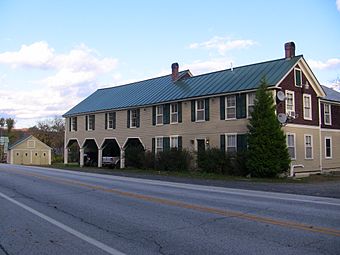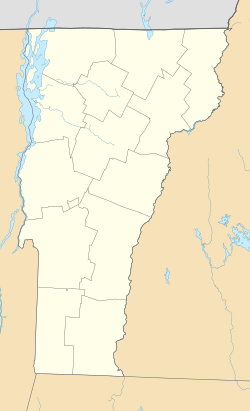Locust Creek House Complex facts for kids
Quick facts for kids |
|
|
Locust Creek House Complex
|
|
 |
|
| Location | VT 12, Bethel, Vermont |
|---|---|
| Area | 1.3 acres (0.53 ha) |
| Built | 1837 |
| Built by | Putnam, Daniel |
| NRHP reference No. | 82001766 |
| Added to NRHP | December 10, 1982 |
The Locust Creek House Complex is a group of old buildings in Bethel, Vermont. It started as a public house, called a tavern, in 1837. Later, it became a farm. This complex is special because it's one of the few old rural taverns left in Vermont. It also shows how buildings were changed over time to become farm buildings.
In 1982, the property was added to the National Register of Historic Places. This means it's an important historical site in the United States. Today, the buildings are used as homes.
What is the Locust Creek House Complex?
The Locust Creek House Complex is located on the east side of Vermont Route 12. It's a collection of wooden buildings, some one story tall and some two stories. Most of these buildings are connected to each other.
How the Buildings are Connected
Along the road, you'll see the main house and a large carriage barn. The carriage barn has open areas on the ground floor, which were used for vehicles. A smaller section extends from the back of the main house. A larger barn is connected to the carriage barn. Another small shed extends even further north from the side of the barn.
Some parts of these old buildings now have a modern metal roof. The open areas of the carriage barn are now used for parking cars.
History of the Buildings
The main house is the oldest part of the complex. It was built in 1837 to be a tavern. A tavern was a place where travelers could stop for food, drinks, and a place to sleep. However, this tavern didn't make much money. It changed owners and renters several times in its early years.
In 1860, the carriage barn was added. This new part included a large ballroom on the second floor. The ballroom had a special type of floor called a sprung floor. This kind of floor is built to be a bit bouncy, which was perfect for dancing! At this time, the complex was called a hotel. It became a very popular place for dances and other social events in the area.
However, the railroad was built far away from the complex. This meant fewer travelers came by, and the hotel eventually closed in 1899. For the next 50 years, in the first half of the 1900s, the complex became the main part of a small dairy farm.



